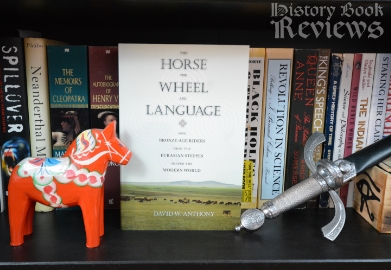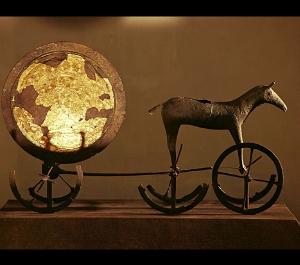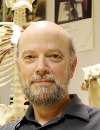The Horse, the Wheel and Language: How Bronze-Age Riders from the Steppes Shaped the Modern World
by David Anthony

Review
My journey through this book, not unlike the prehistoric Eurasian steppe cultures' journey south to the Mesopotamian world, was long, fascinating, and sometimes laborious. David Anthony guides the reader through thousands of years of archaeology and cultural development, several different scientific disciplines, and a sometimes incomprehensible comparison of pottery styles to tell the story of the Indo-European speaking people and the language they bequeathed to much of the modern world.
My first impression about this book was that it was going to be way over my head, filled as it was with excavation grid drawings, radiocarbon date tables, and words in a language that was never written down and no longer exists. Overall, it was. Happily, though, I often enough found The Horse, the Wheel, and Language to be engaging and intelligent, sometimes poignant, and sometimes so thrilling that I couldn't bear to put it down. This contrasted sharply with other moments, when I could hardly even comprehend the words that were written down because the ideas and methodologies were so complex and convoluted. This made for a really interesting reading experience---I was simultaneously SO glad I was reading it and SO glad to finally be done with it!
I first heard about Indo-European and the linguists who try to recreate it in college and remember being enthralled and also skeptical. The idea is that many of the world's languages seem to share a similar root, from Germanic and Greek to Slavic and Anatolian, and even Indo-Aryan languages. Based on these similarities, linguists work backwards to try to rebuild the prehistoric language. This would be absolutely genius if it were true, but I have a hard time believing in it entirely. I'm no linguist, but I don't really see any connection between "mexe" and "h2mey-gw", or between "nime" and "h3neh3mn". The cognates that linguists recognize from different languages that share the same root include "hvél", "hweohl", "čaxtra", and "kuklos" (all meaning "wheel"). I would never have seen a strong enough similarity between those words to group them all together, but I guess that's why I'm no Rasmus Rask or Marija Gimbutas! All kidding aside, I can grasp (however dimly) the real scholarly work behind the attempt, and I do think the reconstructed Indo-European language study has scientific merit, even though I have to take some of it on faith.

The Trundholm Sun Chariot, a Bronze-Age artifact displaying the knowledge of harnessed horses and spoked wheels. Found in Denmark in 1902.
The mission of The Horse, the Wheel, and Language is to put forth an argument for where and when this semi-hypothetical language developed and was used. Anthony believes it developed in the Eurasian steppes, in what is today Ukraine and southern Russia, about 4500 B.C.E. He charts the timeline for when all the daughter languages split apart from the mother tongue and moved across the globe due to migrations out of the steppes. Some of this is documented factually through archaeological finds (so much pottery) and some of it is so theoretical that I could hardly follow. At one point Anthony actually uses TWO reconstructed dead languages and their speculative lifetimes and geographical homelands to demonstrate grammatical and lexical borrowing into ANOTHER reconstructed, older dead language. It was like trying to think 15 moves ahead in Sudoku...at a certain point your brain just shuts down. At these parts in the book I was mentally just smiling and nodding my way through.
Other parts of the book were literally mind-blowing, and actually changed my life. Seriously, I would never in a million years have guessed how much grammar shapes our world view and our perspectives on life. It was riveting to read about how this Indo-European culture has been fixed in time by using clues from the language. Anthony analyzes the rate of change in vocabulary and dates words for "horse", "wheel", and textiles, and then examines the archaeological evidence for when those things entered the region or were invented: There is extensive analysis of when horses were first domesticated and used for food, riding, and pulling wagons and chariots; of the archaeological origins of wheeled vehicles; and of the origin of weaving and other textile crafts. The other mind-blowing thing I learned from this book is that the East Slavic term for a burial mound is a kurgan...am I the only one delighted by the fact that if you google "Kurgan", the Highlander character comes up as one of the first results???
I would be remiss if I didn't drive home how difficult it was at times to get through this book. The last few chapters focus on the archaeology of the Eurasian steppe herding cultures, and it reads more like a giant excavation report rather than a narrative or discussion. There is not much of an attempt to sum up what it all means for a non-archaeologist. Even if you have studied archaeology, it's still incredibly difficult to digest. There are sentences I had to read several times and still could barely make sense of, like this one: "Imported pots of the late Tripolye A2 Borisovka type have been found in DDII settlements at at Grini, Piliava, and Stril'cha Skelia in the Dnieper valley, and sherds from three Tripolye A pots were found at the DDII Nikol'skoe cemetery." It doesn't help that I am completely unfamiliar with the names of archaeological cultures and horizons from this part of the world, but even if I knew it well the barrage of information about categories of pottery and numbers of animal bones and grave goods would still be overwhelming. I'm ashamed to say the only thing that really stuck out from this section was how much the elites loved their boar's tusk plaques as status symbols.
There is so much more detail I could give about this book and all it covers, but suffice it to say that it is immensely worth the read if you are interested in this topic. But it's definitely not a pool-side read, or something to read for light entertainment. It delves very deeply into complex subjects from a multi-disciplinary perspective, and is clearly written by an archaeologist, albeit one who writes very well to a non-scientific audience. It captivated my attention and my fascination more than any book has done in long time, even though parts it felt like a chore and I couldn't wait to be done with it. But the information is invaluable, the subject is mesmerizing, and the implications for our past and our current existence are staggering. When it comes to books on this subject, there can be only one: The Horse, the Wheel, and Language.



